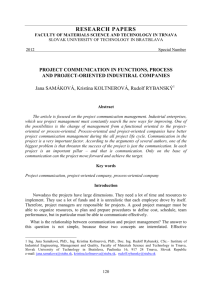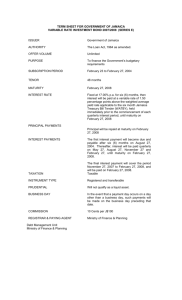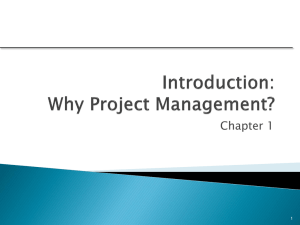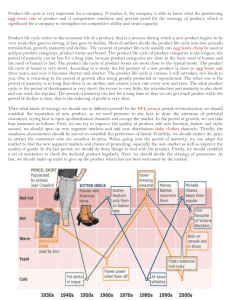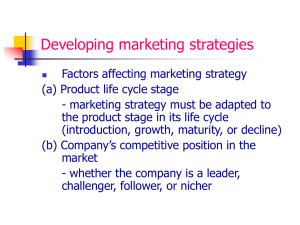MATURITIES OF PROJECT-ORIENTED COMPANIES OF ABOUT 15
advertisement
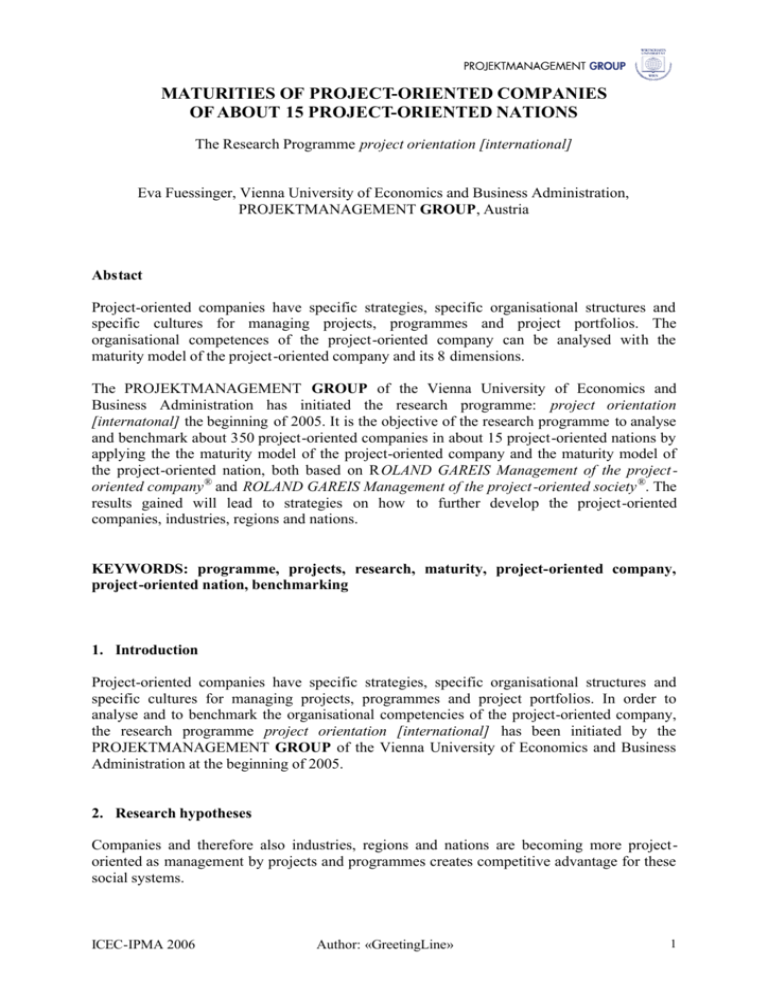
MATURITIES OF PROJECT-ORIENTED COMPANIES OF ABOUT 15 PROJECT-ORIENTED NATIONS The Research Programme project orientation [international] Eva Fuessinger, Vienna University of Economics and Business Administration, PROJEKTMANAGEMENT GROUP, Austria Abstact Project-oriented companies have specific strategies, specific organisational structures and specific cultures for managing projects, programmes and project portfolios. The organisational competences of the project-oriented company can be analysed with the maturity model of the project-oriented company and its 8 dimensions. The PROJEKTMANAGEMENT GROUP of the Vienna University of Economics and Business Administration has initiated the research programme: project orientation [internatonal] the beginning of 2005. It is the objective of the research programme to analyse and benchmark about 350 project-oriented companies in about 15 project-oriented nations by applying the the maturity model of the project-oriented company and the maturity model of the project-oriented nation, both based on ROLAND GAREIS Management of the project oriented company® and ROLAND GAREIS Management of the project -oriented society ®. The results gained will lead to strategies on how to further develop the project-oriented companies, industries, regions and nations. KEYWORDS: programme, projects, research, maturity, project-oriented company, project-oriented nation, benchmarking 1. Introduction Project-oriented companies have specific strategies, specific organisational structures and specific cultures for managing projects, programmes and project portfolios. In order to analyse and to benchmark the organisational competencies of the project-oriented company, the research programme project orientation [international] has been initiated by the PROJEKTMANAGEMENT GROUP of the Vienna University of Economics and Business Administration at the beginning of 2005. 2. Research hypotheses Companies and therefore also industries, regions and nations are becoming more projectoriented as management by projects and programmes creates competitive advantage for these social systems. ICEC-IPMA 2006 Author: «GreetingLine» 1 There is a correlation between the results a project-oriented system achieves in projects and programmes and its maturity. The maturities of project-oriented companies and nations can be measured and benchmarked by applying maturity models. Different maturity models are required to analyse the maturities of different social systems, but the maturities of those different project-oriented systems interrelate. Also the different dimensions of a maturity model relate to each other. There is no ideal maturity of project-oriented systems. The competencies required by a company or a nation depend on its context. Knowing the maturity of a project-oriented system is the basis for further developing it. 3. A “Family” of Maturity Models Different maturity models are required to analyse the maturities of project management personnel, of projects and of programmes, of project-oriented companies as well as of projectoriented nations. For this reason the following “family of project-oriented maturity models relating to each other have been developed: • Maturity Model of the Project Management Personnel • Maturity Model of a Project • Maturity Model of a Programme • Maturity Model of the project-oriented Company • Maturity Model of the project-oriented Nation In the research programme project-orientation [international] the maturities of projectoriented companies (Projektmanagement Group, 2005A), based on ROLAND GAREIS Management of the project-oriented Company®, and of project-oriented nations (Projektmanagement Group, 2005B), based on ROLAND GAREIS Management of the project-oriented Nation ® , are analysed and benchmarked. Figure 1: Maturity model of the project-oriented Company Figure 1 shows the maturity model of the project-oriented company, which consists of following eight dimensions: • Project Management: A project is a temporary organisation for the performance of a relatively unique, short to medium term, strategically important business process of medium or large scope. The process consists of the sub-processes project start, project ICEC-IPMA 2006 Author: «GreetingLine» 2 • • • • • • • coordination, project controlling, resolving a project discontinuity and the project closedown. Programme Management: A programme is a temporary organisation for the fulfilment of a unique business process with a large scope. Programme management has the subprocesses programme start, programme co-ordination, programme controlling, eventually the resolution of a programme discontinuity and the programme close-down. Assurance of the Management Quality of a Project or Programme: Management consulting and management auditing are performed in order to assure the management quality in the projects and programmes. Assignment of a Project or Programme: In the process of assigning, the decision of whether or not a project or programme is to be performed is taken. Project Portfolio Management: In the project portfolio coordination the decision is made whether projects will be started or abandoned, priorities between projects are set, and a coordination of the internal and external resources is made. Personnel Management in the project-oriented Company: This dimension includes the recruiting, disposition and (continuous) development of project personnel like project or programme owner, project or programme manager, project team member, project contributor, etc. Organisational Design of the project -oriented Company: This dimension includes the establishment of a Project Management Office, a Project Portfolio Group and Expert Pools, the development of project and programme procedures and standard project plans. Business Process Management in the project-oriented Company: A business process is a clearly defined sequence of tasks in which several roles of one or more organisations are involved. Primary processes, secondary processes and tertiary processes can be differentiated. Figure 2: Maturity model of the project-oriented nation The maturity of the project-oriented nation, shown in figure 2, considers the practices of its project-oriented companies and by additional project-management-related services like: • Project Management Education: Formal PM Education programmes are provided by different institutions and might lead to academic degrees in project management. The project management approach taught and the number of courses vary in different programmes. ICEC-IPMA 2006 Author: «GreetingLine» 3 • • Project Management Research: PM research projects and programmes, project management-related publications and events and project management-related research financing are services provided by PM research institutions. Project Management Marketing: The primary PM marketing institution in a projectoriented system is the national project management association. Services like membership, competence baseline, certifications of project managers, project management events, etc. are services provided by these institutions. 4. Context of the research programme project orientation [international] The research programme project orientation [international] is based on the results of the IPMA research initiative “Project oriented Society (POS)” (1999-2002) as well as the pilot project project orientation [austria], which was conducted at the PROJEKTMANAGENT GROUP from January 2004 until July 2005. With regard to the POS the questionnaire used for the analysis has been further developed and nations like Austria, Latvia, Norway, Romania and United Kingdom have agreed to participate in this programme, in order to do a reassessment. The main difference between POS and project orientation [international] is that the analyses start from the bottom. This means that first the companies are analysed and then the nation, while in POS the analysis took only place on the nation’s level. The developments derived from POS have been tested in project orientation [austria] and even been further developed. 5. Results of the pilot project project orientation [austria] The research project project orientation [austria] started in January 2004 and closed-down in July 2005. The main objectives of this pilot project for the research programme project orientation [international] was to analyse about 60 project-oriented companies from 5 different industries as well as of Austria as a project-oriented nation. Following interpretations of the results of the analysis of project-oriented companies were possible: • The project management maturity is higher than the programme management maturity. • The processes to assure the management maturity of a project or programme are hardly established. • To reach a high maturity in project management the maturity of organisational design and personnel management has to be high. • The maturity of the project start is higher than the maturities of the project controlling and project close-down. • A high project management maturity leads to good project results. • A high business process management maturity leads to good project results. ICEC-IPMA 2006 Author: «GreetingLine» 4 Ø 7 POC: Building and Civil Construction Ø 11 POC: Best POC in PM Engineering Construction Worst POC in PM Ø 60 POC: Austria Ø 5 POC: Research Ø 11 POC: ICT Best POC Austria Ø 5 POC: Consulting Ø 6 POC: NPO/ Public Services Maturity Ratio 39% 40% 46% 48% 49% 60% 67% Project management 58% 66% 70% 60% 65% 71% 77% Programme management 25% 13% 14% 2% 25% 49% 52% Assurance of management quality in projects and programmes 21% 9% 14% 27% 27% 29% 54% Assignment of a project or a programme 65% 49% 38% 53% 60% 67% 75% Project portfolio coordination and networking between projects 22% 25% 47% 47% 45% 69% 62% Organisational design of the project -oriented company 39% 47% 66% 56% 56% 65% 72% Personnel management in the project -oriented company 33% 40% 54% 50% 47% 60% 62% Business process management in the project -oriented company 18% 37% 30% 65% 48% 56% 63% Figure 3: Benchmarking of the maturities of different industries of Austria (Gareis R. & Gruber C., 2005.) Figure 3 shows the benchmarking of the maturities of different industries as well as the average maturity of 60 project-oriented companies. PROJECT MANAGEMENT 100 PROJECT MANAGEMENT MARKETING 80 75% 65% PROGRAMME MANAGEMENT 60 40 PROJECT MANAGEMENT RESEARCH 20 48% ASSURANCE OF THE MANAGEMENT QUALITY OF PROJECTS OR PROGRAMMES 25% 27% 0 53% PROJECT MANAGEMENT 60% EDUCATION PROJECT PORTFOLIO MANAGEMENT 48% 47% 56% BUSINESS PROCESS MANAGEMENT IN THE PROJECT-ORIENTED COMPANY PERSONNEL MANAGEMENT IN THE PROJECT-ORIENTED COMPANY ORGANISATIONAL DESIGN OF THE PROJECT-ORIENTED COMPANY Figure 4: Maturity of Austria in 2005 (Gareis R. & Gruber C. 2005) To determine the maturity of Austria as a project-oriented nation the results from the projectoriented companies have been aggregated and in addition the project management-related ICEC-IPMA 2006 Author: «GreetingLine» 5 services have been considered. These have been analysed by interviewing experts, searching the internet, analysing documents, etc. The maturity of Austria as a project-oriented nation is shown in Figure 4. The maturity ratio for Austria in 2005 is 49%. 6. Structure of the research programme project orientation [international] The research programme, which started in January 2005 and will end in July 2007, is managed by the PROJEKTMANAGMENT GROUP of the Vienna University of Economics and Business Administration, Austria. It is partly financed by the European Regional Development Fund. It is the objective of the research programme to analyse and benchmark about 350 projectoriented companies in about 15 project-oriented nations. Once the project-oriented companies of all the participating nations have been analysed the maturity of the project-oriented nations will be analyzed and benchmarked. The results gained by these analyses will lead to strategies to further develop the project-oriented companies, industries, and nations. Up to now 13 nations, Australia, Austria, Finland, France, Germany, Iran, Latvia, Lithuania, Norway, Romania, Slovakia, South Africa and United Kingdom, have agreed to participate in the research and have partly started their national research projects. 7. Research Process in the Research Programme project orientation [international] The first part of the research has to be performed in each national project. It includes the analysis of the maturity of project-oriented companies as well as the analysis of the projectoriented nation. In the second part the international benchmarking is performed. The analysis of the maturities of the project-oriented companies includes the following steps: • Briefing workshop for project-oriented companies: During this workshop the process of the analysis, the maturity model including the questionnaire will be explained to representatives of project-oriented companies. • Self-analysis: At least 5-10 representatives per company answer the online questionnaire individually. Alternatively the representatives take part in a moderated analysis workshop to fill out the questionnaire together. • External analysis: Relevant documents (e.g. project management procedures, project documentations, etc.) provided by the project-oriented company are analysed by the national research team. This is to verify the quality of the results of the self-analysis. • Benchmarking: Comparison of a company’s maturity with maturities of other projectoriented companies. • Analysis and benchmarking report: This report includes the analysis and the benchmarking as well as the definition of potentials for the further development of the maturity of the company. The analysis of the maturity of a single project-oriented nation includes the following steps: ICEC-IPMA 2006 Author: «GreetingLine» 6 • • • Analysis of project-management-related services: The education, research and marketing services in the nation is analysed by internet search, documentation analysis and interviews of project management experts. Analysis workshop for the project-oriented nation: Results of the analysis of projectoriented companies are consolidated to define the maturity of project-oriented industries and the project-oriented nation and potentials for the further development of the maturities are defined. Analysis and benchmarking report: All results and suggestions for development are summarised in this report. The second part of the research process has the objective to compare the achieved national results internationally: • International benchmarking workshop: In a workshop the results of analysis of the nations are discussed and benchmarked. • International benchmarking report: The results of the international benchmarking and suggestions for the further development of maturities are summarised in this report. 8. Conclusion Given from the result of the pilot project project orientation [austria], the analyses of the project-oriented companies within the research programme will not only focus on the industries, but also on the size of a company and the different project types a company is carrying out. The challenge of project orientation [international] will be the programme management, since the projects are performed in different countries all over the world. But with the help of new technology (internet, homepage,…) and a standardised communication and controlling system, the programme office tries to keep transparency and an overview over the progress of the whole programme. References 1. Gareis R. (2004): Management of the Project -oriented Company, in: Wiley Guide to Managing Projects, Wiley & Sons, Hoboken, New York. pp. 123-143. 2. Gareis, R. (2005) Happy Projects!. Vienna: Manz. 3. Gareis, R. & Gruber, C. (2005): Analysis of project-oriented Companies and of Austria as a project-oriented Nation. Downloads. http://www.wu-wien.ac.at/pmg_engl [accessed 9 December 2005]. 4. Gareis R., Huemann M. (2001): Assessing and Benchmarking Project-oriented Societies, in: Project Management: International Project Management Journal. 7 (5) pp. 14-25. 5. Gareis R., Verster B. (2005): project orientation [international] – Benchmarking the Maturities of project-oriented Companies, Industries and Nations, presented at: pm days ’05, Vienna. 6. Huemann M., Lethonen M., Volle J.S. (2005): Maturities of project-oriented nations Austria, Finland and Norway, presented at: pm days ’05, Vienna. 7. Projektmanagement Group (2005A) ‘Questionnaire: Management of the project-oriented Company’. http://www.pmgroup.at/questionnaire_poc [accessed 9 December 2005]. 8. Projektmanagement Group (2005B) ‘Questionnaire: Management of the project-oriented Nation’. http://www.pmgroup.at/questionnaire_pon [accessed 9 December 2005]. 9. www.poa.pmgroup.at (21.10.2005). 10. www.poi.pmgroup.at (21.10.2005). ICEC-IPMA 2006 Author: «GreetingLine» 7
